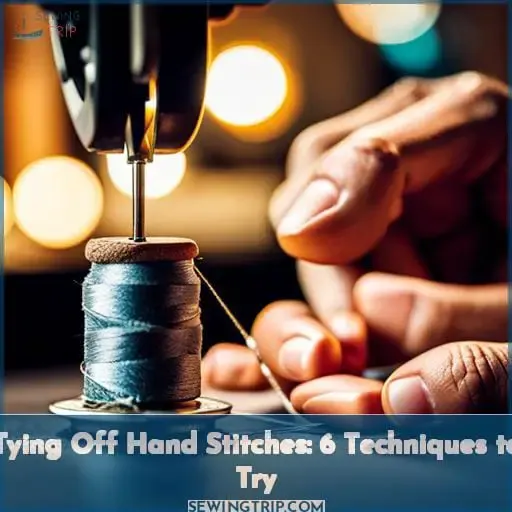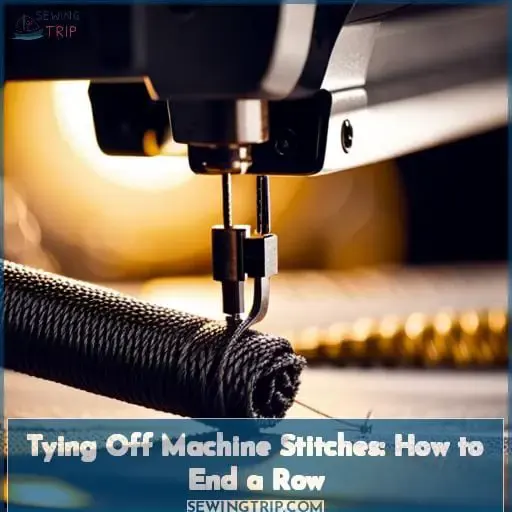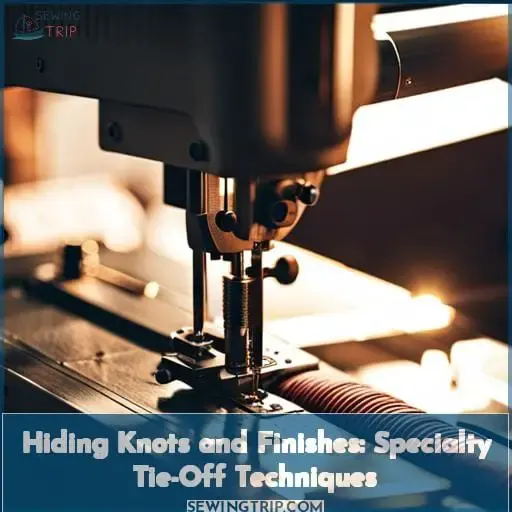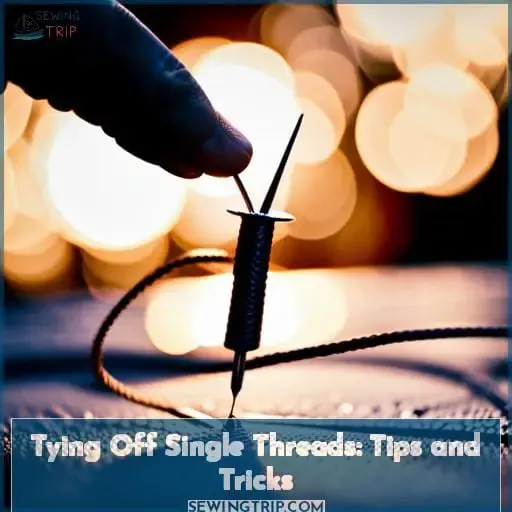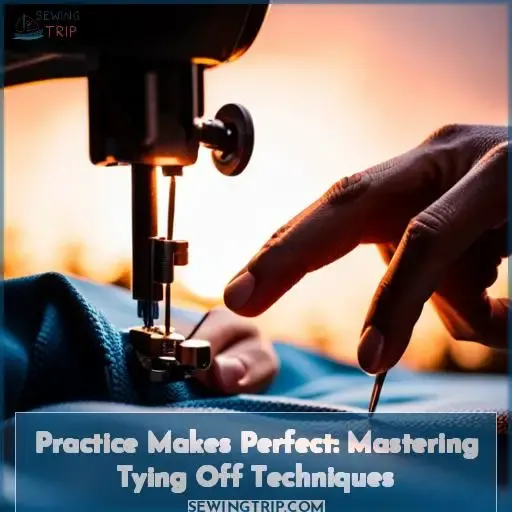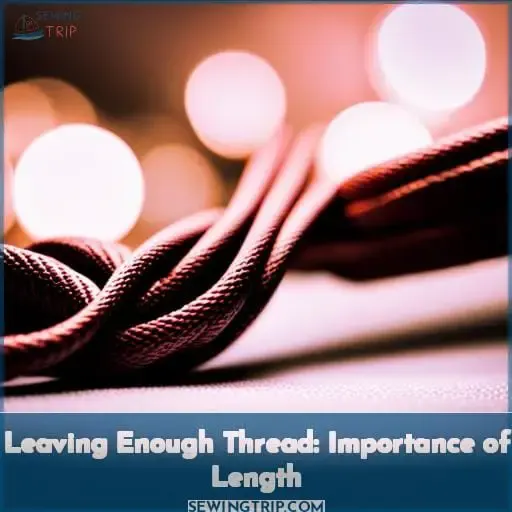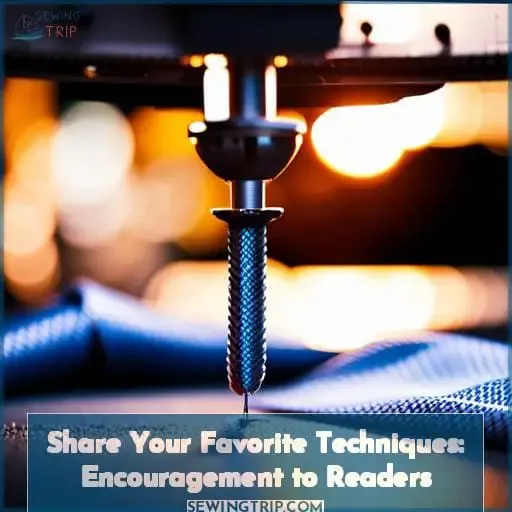This site is supported by our readers. We may earn a commission, at no cost to you, if you purchase through links.
Welcome to the world of sewing! In this lesson, you will learn how to tie off your stitches properly and securely, whether you’re using a needle and thread or a sewing machine. Tying off is an essential step for any successful project, as it not only adds strength but can also enhance the aesthetic appeal when done correctly.
We’ll walk through all the different methods so that by the end of this article, you’ll have mastered each one.
Table Of Contents
- Key Takeaways
- Essential Tools for Tying Off Stitches
- Tying Off Hand Stitches: 6 Techniques to Try
- Tying Off Machine Stitches: How to End a Row
- Hiding Knots and Finishes: Specialty Tie-Off Techniques
- Tying Off Single Threads: Tips and Tricks
- Practice Makes Perfect: Mastering Tying Off Techniques
- Leaving Enough Thread: Importance of Length
- Share Your Favorite Techniques: Encouragement to Readers
- Frequently Asked Questions (FAQs)
- Conclusion
Key Takeaways
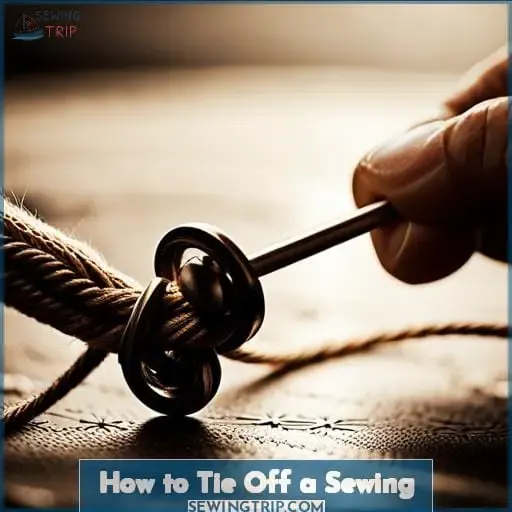
- Tying off stitches is essential for both strength and aesthetic appeal in sewing projects.
- The technique used for tying off depends on the type and number of threads being used, and tools such as scissors are necessary.
- Hand tying off involves cutting the thread to the desired length, creating an anchoring knot, and hiding it between layers of fabric or using a quilter’s knot.
- Proper thread tensioning, seam tensioning, knot tying, and fabric pressing are crucial for a secure tie-off, and leaving enough thread length at the end of each row or stitch is important.
Essential Tools for Tying Off Stitches
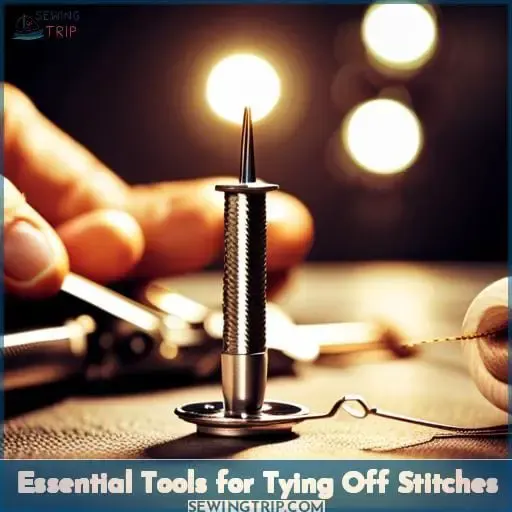
Having the right tools on hand is essential for ensuring that your stitches stay securely tied off, so grab a pair of scissors and get ready to impress! When tying off a sewing project, you should always leave room at the end of each row or stitch.
This is enough space to accommodate any knot types. Depending on the type of thread you choose for your embroidery finish, it may be necessary to use a quilter’s knot or other special technique to tie off more complex rows of stitches.
For single threads and rows with fewer than seven inches of thread remaining, an end-off backstitch can be used. If double threads are present in any part of your project, consider using one of four methods specifically designed for this purpose: square knots alternating looped double knots, figure eight loops, crossed over twists, and larkshead ties with two half hitches.
Finally, remember that practice makes perfect when mastering these techniques. So don’t give up, even if things get tricky!
Tying Off Hand Stitches: 6 Techniques to Try
Tying off hand stitches is an important aspect of any sewing project, and there are numerous ways to accomplish it. In this discussion, we will focus on six primary techniques: tying off a double thread with method 1, method 2 (finishing stitch), method 3 (backstitch), method 4 (end-off backstitch), and finally, tying off a double thread using Method 5.
Tying Off a Double Thread, Method 1
If you’re working with a double thread, start off by trying the square knot technique – it’s an easy one to master! To tie off your last stitch securely, try regular tying-offs, quilter’s knots, hiding knots between layers of fabric, and special techniques for tricky situations.
Pinning fabric, pressing cloths, and cutting threads also help create a professional finish.
Tying Off a Double Thread, Method 2 (Finishing Stitch)
Finishing off stitches with a double thread can be easily achieved by mastering the Figure Eight technique. This technique will make you feel like an ace in no time! Proper thread tensioning, seam tensioning, knot tying, and fabric pressing are all crucial elements of this powerful tie-off.
To ensure success, use a lockstitch button to secure the final pull before cutting threads. Whether using a sewing machine or hand sewing techniques, knowledge of tie-off methods is essential for achieving the best results.
With practice and attention to detail, you can become confident in creating beautiful seams that will last.
Tying Off a Double Thread, Method 3 (Back Stitch)
Grasping both threads in one hand, bring the needle back through the fabric to create a single line of stitches that will securely lock your threads. It is important to leave enough length at the end for backstitching to secure the thread and prevent unraveling.
Sewing machines offer the Lockstitch Method or Auto Finish Function, which can make tying off easier. For hand quilting, the Quilter’s Knot provides an extra secure way by taking two strands in opposite directions before knotting them together at the end of your final stitch.
Tying Off a Double Thread, Method 4 (End-Off Backstitch)
Take your stitching to a whole new level with the End-Off Backstitch! This incredibly secure method for tying off double threads dramatically boosts the strength of your work. Leave room at the end of each row and finish by making two small stitches in opposite directions.
Secure knots by pulling gently on both ends until the thread length is just right – not too tight or too loose. Use a quilter’s knot if needed, then sew the first part of the knot through the fabric edge and back onto the wrong side of the project before trimming excess threads away.
With practice, you can master this technique which works well for both hand and machine sewing.
Tying Off a Double Thread, Method 5
Hold the two threads securely and use your fingers to twist them together three times. Leaving length, making a lockstitch, and tying hidden knots are all key techniques for auto-finishing stitches.
- Make sure there’s at least an inch of thread left on each side.
- Create a loop by folding both strands in half – then pull through.
- Hold the end firmly and gently tug until it forms a knot!
A lot of effort goes into finishing stitches correctly – but learning these easy ways will make it much easier.
Tying Off Machine Stitches: How to End a Row
You have a few options when it comes to tying off your machine stitches. The first option is making a lockstitch. This involves stitching forward and then backward at the end of the row and cutting off any excess thread.
Another method is using the auto-finish function on some more advanced machines. This allows you to simply press a button to tie off your stitch with ease. Finally, if neither of these methods are available or practical for you, tying off by hand can be done as well.
Method Making a Lockstitch
Pull both ends of the thread through to create a lockstitch, and you’ll be able to confidently finish your stitches! Achieving this is easy if you rethread needles correctly, adjust tension, tighten the thread as needed, and weave it in place.
Variations on this technique can help when tackling lots of hand-sewing projects.
Method Using the Auto-Finish Function
Forget about complicated knots and threads – you can easily finish your stitches with the auto-finish function! Many modern sewing machines have a special lockstitch setting that will tie off your seams at the end.
This is often referred to as an auto-finish or knotting basics setting. When using this, make sure you leave several inches of thread on both ends for proper knotting and seam finishes.
Lockstitches are usually preferred over quilter’s knots because they provide stronger, more secure results while taking up less space in between layers of fabric.
It’s quick and easy – ideal for those who want to get their sewing projects done in a jiffy but still ensure everything looks perfect when finished! Choose the simplest way; use an auto-finished stitch every time!
Method Tying Off by Hand
Don’t worry if you don’t have an auto-finish function – you can still tie off your hand stitches with ease!
To do so, begin by cutting the thread length to leave several inches at the end. Then create an anchoring knot for extra security and hide it between layers of fabric or use a quilter’s knot.
Practice makes perfect when mastering tricky specialty techniques such as these. Ask fellow sewers for their favorite methods in the comments section!
With just a few steps, finishing those stitches securely and attractively is possible.
On to pressing, pinning, and cutting fabrics next lesson…
Hiding Knots and Finishes: Specialty Tie-Off Techniques
If you’re looking for ways to conceal knots and finishes when sewing, try out these specialty tie-off techniques. You can hide a knot between layers of fabric by making sure the two sides overlap slightly and tying them off with an overhand knot.
This prevents the knot from showing on either side. Another way to keep a hidden finish is to use a slipknot – simply run your thread through twice before pulling tight. It will stay secure without being seen from the outside. Finally, tuck ends into seams or stitch them down at an angle so that they become part of the garment’s construction rather than sticking out as unfinished details.
Hiding Your Knot Between Layers
Secure your stitches with ease by weaving the thread between fabric layers like a spider’s web, creating an anchor that will hold tight. A quilter’s knot is extremely effective when used as a finishing stitch to end off backstitches and lockstitches.
Alternatively, you can use modern machines’ auto-finish function for perfect results each time. By taking extra care in hiding knots between layers of fabric, you can ensure professional-looking projects every single time, whether using traditional hand techniques or modern technologies.
Another Way to Hide a Knot
Try experimenting with a bar tack to easily secure your stitches and hide any knots beneath the fabric. Use quilter’s knots to adjust fabric tension while finishing ends for an invisible knot. End off stitches in different ways by varying knot variations or hiding them under multiple layers of fabric – just be sure to leave enough thread! You’ll gain confidence as you practice these techniques and master the art of tying off stitching securely and attractively.
Hiding Your Finish in a Seam
Hiding your finish in a seam is an effective way to ensure your stitches look neat and professional without sacrificing strength. For single threads, leaving knots at the end of each line can be enough for security.
When finishing seams, try using the lockstitch method or take advantage of auto-finish functions on sewing machines. This will not only make sure that all ends are securely locked but also give you a great-looking finished product! With practice and patience, you too can learn to master these techniques for beautiful results every time.
Tying Off Single Threads: Tips and Tricks
Now that you know how to hide knots and take on specialty tie-off techniques, it’s time to learn how to tackle single threads. Tying off a single thread is different than tying off a double thread, but with the right technique, your stitches will be secure and attractive.
To begin, adjust the tension of your needle’s thread so there isn’t too much slack in it when you are stitching. This will help ensure that all of your stitches come out even at both ends. You can then choose from several methods: perform a lockstitch or make an overhand knot for hand-sewing projects; use back stitch or an invisible quilter’s knot for machine-stitched pieces.
For tricky situations where excess fabric makes traditional ties difficult, try using one of those specialty techniques discussed earlier. They provide more control over tight spaces while still giving great results! With practice comes perfection – keep practicing these simple tips until they become second nature.
Practice Makes Perfect: Mastering Tying Off Techniques
You’ve already learned the basics of tying off, but it’s time to up your game and take your sewing skills to a whole new level! With practice, you can master different ways of tying off that will help you finish stitches securely and attractively.
Different types of knots, like lockstitches, can be used when cutting thread at the end for added security. You may also want to try hiding knots between layers or using a quilter’s knot for intricate projects.
Remember not to forget leaving several inches so as not to have difficulty in finishing the stitch correctly on the next row or project after undoing all work done before tie-off.
Keep trying different approaches – soon enough, it’ll become second nature and positively impact both hand and machine sewing projects alike! Have faith: if practiced diligently, proper tie-offs will come easily–and then there won’t be any stopping you from doing an excellent job every single time.
Leaving Enough Thread: Importance of Length
Leaving plenty of thread at the end of your stitches ensures that you can tie them off securely and neatly. When finishing a project, it’s important to leave at least three inches or more for easy tying off.
Whether using knots or specialized techniques such as lockstitches and the quilter’s knot, having extra thread length will make things easier.
Having enough thread allows you to easily create secure knots when tying off hand stitching without worrying about running out of material in the middle. Not leaving enough room is likely to result in weak spots which could come undone with wear over time.
This becomes even more pertinent if machine sewing is involved since those require longer lengths for proper tensioning.
Leaving too little also makes it difficult to hide any excess within layers because there simply isn’t enough material available on one side.
- Using Knots:
Having enough thread allows you to easily create secure knots when tying off hand stitching without worrying about running out of material in the middle. - Thread Length:
Not leaving enough room is likely to result in weak spots which could come undone with wear over time. This becomes even more pertinent if machine sewing is involved since those require longer lengths for proper tensioning. - Finishing Stitches:
Leaving too little also makes it difficult to hide any excess within layers because there simply isn’t enough material available on one side. But when given sufficient space, cleverly placing a knot between fabrics can add an aesthetic touch while ensuring strength as well!
Share Your Favorite Techniques: Encouragement to Readers
Share your favorite tying techniques with us – like a painter’s brush stroke on canvas! Tying off is essential for securing stitches and ensuring durability. Whether you prefer using quilter’s knots, specialty knots, or the lockstitch method, mastering these techniques will elevate your sewing game.
For machine stitching enthusiasts, take advantage of the auto finish function to save time while achieving a polished look. Hand-stitchers can experiment with different methods for tying off rows of stitching or double threads to find their preferred approach.
A well-executed tie-off not only provides strength but also enhances the overall aesthetic appeal of your project.
Take pride in refining this skill and share what works best for you in our community! Remember that practice makes perfect when it comes to tying off – so keep honing those skills until you achieve mastery over them.
| Technique | Description |
|---|---|
| Quilter’s Knots | Used for joining thread ends without leaving bulky knots; ideal when hiding knot between fabric layers |
| Specialty Knots | Variations include surgeon’s knot (adds extra security), buttonhole stitch (for decorative purposes), and French knot (creates raised texture) |
| Lockstitch Method | Used primarily by hand-sewers; involves weaving needle through previous stitches before making final tie-off |
| Auto Finish Function | Time-saving feature found on machines that automatically completes last few stitches before cutting thread |
Keep exploring new ways to master these methods based on personal preferences – as there are multiple approaches available depending upon convenience level.
Frequently Asked Questions (FAQs)
What is the difference between a machine and a hand stitch?
Do you know the difference between a machine and hand stitch? Machine stitches are quicker but may not be as durable or precise. Hand stitching allows for more control and customization, but can take longer to complete.
How often should I practice tying off stitches?
To master tying off stitches, practice regularly. Start by trying different methods and techniques until you find what works best for you. Interestingly, studies show that consistent practice leads to better results in sewing projects overall.
What are the most common mistakes to avoid when tying off stitches?
To avoid weak stitches, it is important to never rush the tie-off process. Common mistakes to avoid include cutting threads too short or tying knots too tightly. Remember to leave ample thread and practice various techniques for optimal results.
What is the best way to hide knots between layers of fabric?
To conceal knots between layers of fabric, utilize a quilter’s knot or bury the knot in between stitches. Insert the needle into the fabric and create a small stitch to hide it within the layers.
How can I ensure that my stitches are secure and attractive?
To ensure that your stitches are both secure and attractive, it is important to use the appropriate tying off technique for both hand and machine sewing. Make sure to leave several inches of thread at the end of each row, practice various methods, and conceal knots between fabric layers if necessary.
Conclusion
You’ve come a long way in learning the proper techniques for tying off stitches. By now, you know the importance of tying off securely and attractively, and you understand the need to leave enough thread at the end of a row of stitches.
It’s time to practice! Keep practicing and experimenting with different techniques until you’ve mastered the art of tying off. Your hard work will be rewarded with professional-looking results that can withstand the test of time.
Plus, you can show off your newfound skill to friends and family. So don’t be afraid to dazzle them with your knowledge! After all, practice makes perfect.

